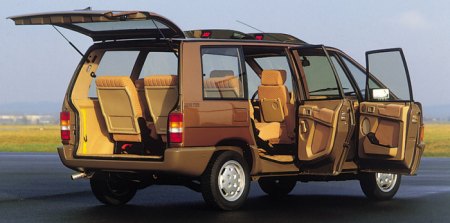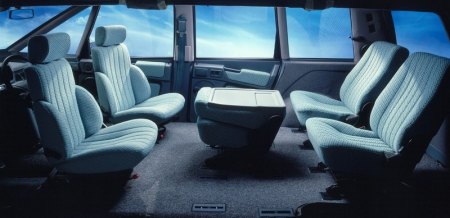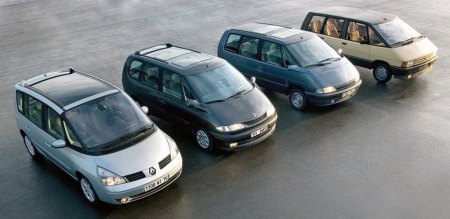 Incidentally, 3 original
concepts of MPV (Multi-Purpose Vehicle) debuted on different continents
at about the same time. In America, Chrysler introduced the twins Dodge Caravan and Plymouth
Voyager in 1983. The same year saw Mitsubishi Space Wagon
went on sale in Japan. Just a year later, Europe also entered MPV-era
with the debut of Renault Espace. Although the Renault arrived a little
later than the other two, it was still 10 years ahead of its closest
European rivals – the 1994 Peugeot 806 / Fiat Ulysse and 1995 VW Sharan
/ Ford Galaxy. Moreover, with a more innovative packaging and more
flexible seating arrangement than those of the Chrysler and Mitsubishi,
it undoubtedly had greater influence to the MPVs we see today. It is
fair to call it the ancestor of modern MPVs.
Despite of its Renault badge, the original Espace was actually conceptualized and produced by Matra, a French company whose business ranged from aerospace, defense to racing cars and niche cars production. Before Espace, Matra had been producing a few odd sports cars and offroaders at its Romorantin plant in France. In 1979, it started working on a monospace people mover that would be completely unique in the market. The original idea was to sell it to PSA group, which owned 50 percent stakes in Matra then. Somehow, PSA turned down the proposal. This led to Matra cutting its ties with the group and turning to Renault. The latter showed much more interest and eventually forged a partnership. The car was redesigned to satisfy Renault's requirements and to use as far Renault components as possible. Production was handled by Matra and sales was responsible by Renault.  The Espace had a unique body construction. Its chassis was a fully galvanized steel spaceframe that looked like a conventional monocoque sans body panels. The latter were made of glass-fiber-reinforced plastics and attached to the skeleton structure. Such design had a number of advantages: lightweight yet rigid, rust-proof and easy repair on minor impacts. Underneath the structure were Renault components (mostly taken from Renault 18 sedan), such as the 2-liter SOHC engine with 110 hp, 5-speed gearbox and double-wishbone front suspensions. At the back, Matra opted for a space-saving torsion-beam axle to reduce intrusion to the cabin/luggage space as far as possible. Like Renault 18, the powertrain was mounted North-South and drove the front wheels. The "monospace" or "one-box" design was new to the market. On the one hand it enabled a low drag coefficient of 0.32, on the other hand it freed up the space ahead of the driver, amplifying the spacious feel. Furthermore, the Espace had large windows, slim pillars hence high percentage of glass area to deliver a light and airy ambience. The cabin was benefited from a flat floor and very versatile seats. The front seats could be rotated 180 degrees so to face the rear passengers. The middle row consisted of 3 individual and identical seats that could be flipped to become a table, tumbled forward to free up luggage space or even completely detached. The rearmost row of 2 seats were optional to fit children (adults would be too cramped). Again they could be folded, tumbled forward or detached. With all but the front seats removed, Espace offered unrivalled luggage capacity.  On the road, the Espace showed a driving manner like normal cars rather than a tall van, no matter in terms of steering, body roll, the level of understeer or high-speed stability. It was also pretty refined, with good ride quality and noise suppression. Performance was quite limited from the 2-liter engine, but that was perfectly adequate for a people mover. Renault sold close to 200,000 units of the first generation Espace until 1991, then switched to Mk2 and then Mk3 in 1997 with even better sales results. Both Mk2 and Mk3 continued to be built by Matra, and they employed plastic body and steel spaceframe chassis like the original car. Thereafter, Renault took production back to its own plant with the 2002 Mk4 and switched to conventional steel monocoque construction. That was also the end of the true Espace. How about Matra then? In exchange of losing Espace it was given the production rights of an MPV-coupe crossover called Avantime, but that turned out to be a commercial failure. Eventually, the Romorantin factory shut down in 2003 and assets were sold to Pininfarina.  |